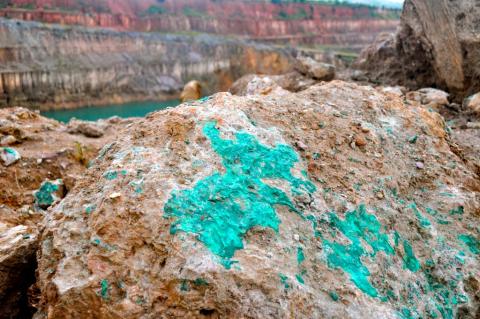
In 2013, 28% of Guinea’s total state revenue came from the mining sector. However, revenue fell by 20% from USD 369m in 2012 to USD 294m in 2013. This was partially due to the fall in the price of bauxite, the country’s main export.
Corporation tax continued to be the main source of government revenue in 2013 even as profits fell, accounting for 35% of the total.
Improving data collection
The amount and value of mineral production in Guinea for 2013 is difficult to say with certainty. The 2013 EITI Report noted that official statistics on production, exports, the sector’s contribution to GDP, employment and estimates for the artisanal mining sector were not easily accessible from the central government. This was coupled with other impediments such as the lack of an official website for the Ministry of Mines and Geology and the lack of an updated mining cadastre.
Regular EITI reporting provides an impetus for the mining cadastre to be updated annually. Through the EITI, companies report on their production. Four of the largest companies[1] (which together accounted for over 82% of the government’s declared mining revenue), reported on their 2013 production and exports. Although this information remains incomplete, it is a healthy development in improving data collection in Guinea.
Similarly, although there were no official figures on artisanal production in 2013, the EITI Report notes that the Kimberley Process reported artisanal diamond production of just over 202,000 carats. Diamond exports were determined as 197,000 carats, with a value of USD 36m.
From recommendations to reform
The 2012 EITI Report recommended better coordination between the Ministry of Mines and Geology (MMG) and the Centre for Mining Promotion and Development (CPDM) to ensure that all companies with mining permits were registered with the MMG. The 2013 Report noted that a one-stop service was created in 2014, to facilitate the registration of new mining companies. Given falling revenues, the government also clarified the law relating to the establishment of new companies which seek to hold mining permits.
The 2013 EITI Report also noted further progress following the publication of the 2012 EITI Report. The MMG has adopted monitoring tables, which have improved the government’s control of mining receipts. The law about new companies holding mining permits in Guinea has also been clarified. This latest EITI Report continues to emphasize the need for capable information systems to track government revenue.
Transfers to local authorities
The Mining Code states that 15% of mining receipts, excluding custom duties on the export of precious stones and other gems, should be allocated to local authorities throughout the country. 5% should also be allocated to the Mining Investment Fund. These payments to local authorities should be disclosed in the Official Gazette and on the website of the MMG.
It has proven difficult to access revenue information from local authorities to verify if these payments have actually been made. However, relying on unilateral company declarations, the 2013 EITI Report notes that at least USD 11m was paid to local communities. Over USD 9m of these contributions were directed to local development. These contributions are formalized through the Convention for the Development of Local Communities and can take the form of scholarships as well as the development of local educational or medical infrastructure. Over USD 1m was paid by companies as voluntary social payments.
Looking forward
The Report does not identify any barter agreements (minerals in exchange for infrastructure) signed between companies and the state in 2013. However, it notes that in June 2014, the National Assembly ratified two such agreements. The first related to Global Aluminia Corporation (GAC)’s investment protocol on the Sangaredi bauxite deposit. This wass part of the company’s strategic attempt to increase upstream investments and was to be based on a two phased implementation. Phase 1 would see the development of a greenfield bauxite mine in Sangaredi, Boké region, Guinea. This includes the construction of a multi-user port terminal and a commercial quay at Port Kamsar; an upgrade to the existing rail system linking the mine and refinery locations with Port Kamsar; various harbour and channel works; and the construction of supporting infrastructure for the mining, rail, port terminal and marine operations.
Similarly SIMFER, of which Rio Tinto is a leading partner, signed an investment protocol linked to the Simandou iron deposit. This was also ratified by the National Assembly in June 2014. The two components of the Investment Framework relate to the creation and operation of the Simandou mine and secondly, the creation and operation of the Simandou rail and port infrastructure.
Publicly available information would allow the public to track these projects as they develop and inform the debate about the management and use of the country’s natural resources.
Contenido relacionado



